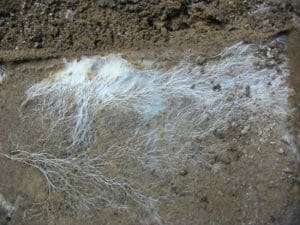Saprophyte Definition
A saprophyte, also referred to as a saprobe or saprotroph, is any organism that feeds and grows on dead organisms. This means that a saprophyte is a decomposer, breaking down complex matter and absorbing the simpler products. Since saprophytes rely on dead plant and animal bodies for food, rather than producing their own as autotrophs do, they are heterotrophs. Keep in mind that although it is still used, saprophyte may be a misleading name, since –phyte means plant. What makes this an issue is that it has been found that no land plants truly feed in the manner that a saprophyte does, but it may seem like it when plants use fungi to acquire nutrients.
Saprophytic nutrition is usually displayed by bacteria and fungi living in moist environments. They decompose organic dead and decaying matter by extracellular digestion, which is the secretion of digestive juices that break down matter around them. In the case of fungi, we find that most are multicellular saprophytes. They grow tubular structures, or hyphae, which are filaments that grow and branch into the dead matter, produce digestive enzymes, and digest away the dead organism. The fungi then absorb the simple substances through their hyphae, which can in time grow into a mycelium, or a mass of hyphae, as seen below.
While extracellular digestion is the means by which most fungi and bacteria acquire their nutrition, bacteria are simpler organisms and do not produce hyphae.
In addition to their preference for humid environments, most saprophytes require oxygen to survive and would die in its absence. They cannot stand very high temperatures, and they thrive in environments with neutral to slightly acidic pH levels.
Function of a Saprophyte
An example of a substance that is only broken down by saprophytes is lignin, which is a major component in many plants and is what gives trees their tough characteristics. Additionally, a saprophyte is helpful to the ecosystem because as it decomposes the bodies of dead organisms, it recycles and releases nutrients into the environment, making them available for other organisms to use. This is especially important for plant growth.
Related Biology Terms
- Detritivore – An animal that lives off dead and decaying matter.
- Parasite – An organism that lives on another living organism and causes it harm.
- Photosynthesis – The process where green plants and other organisms use sunlight to synthesize their own food from carbon dioxide and water.
Quiz
1. How do saprophytic fungi acquire nutrients?
A. By digesting food within their stomachs
B. Through photosynthesis
C. By extracellular digestion, performed by hyphae
D. By eating other living organisms
2. Which of the following is true of most fungi?
A. They are autotrophic
B. They are multicellular saprophytes
C. They are unicellular saprophytes
D. They are unicellular parasites
3. Which of the following describes a mycelium?
A. It is a network of connected hyphae
B. It is the digestive juice produced by hyphae
C. It is the digestive tract of a saprophyte
D. It is a parasitic fungus

